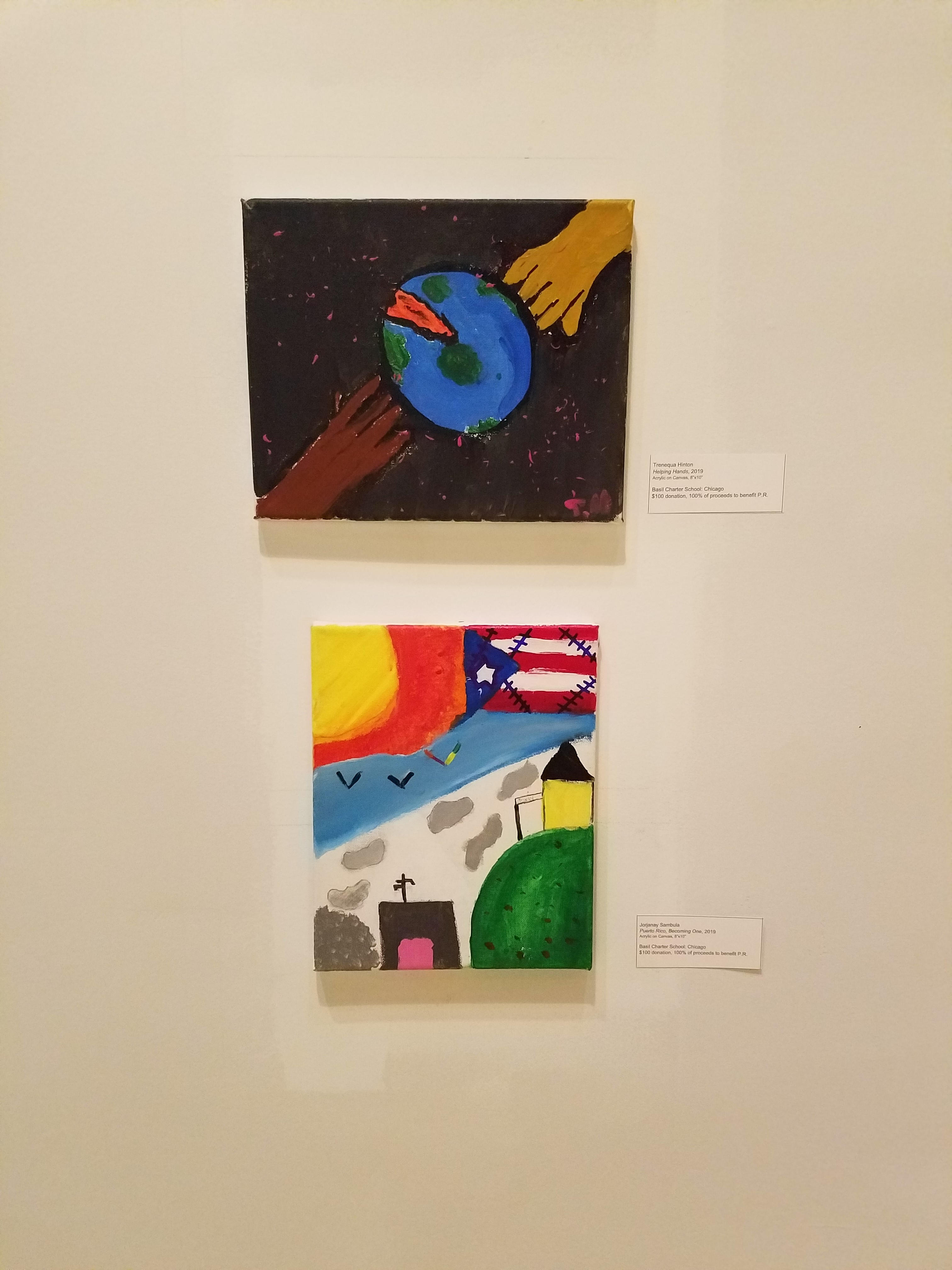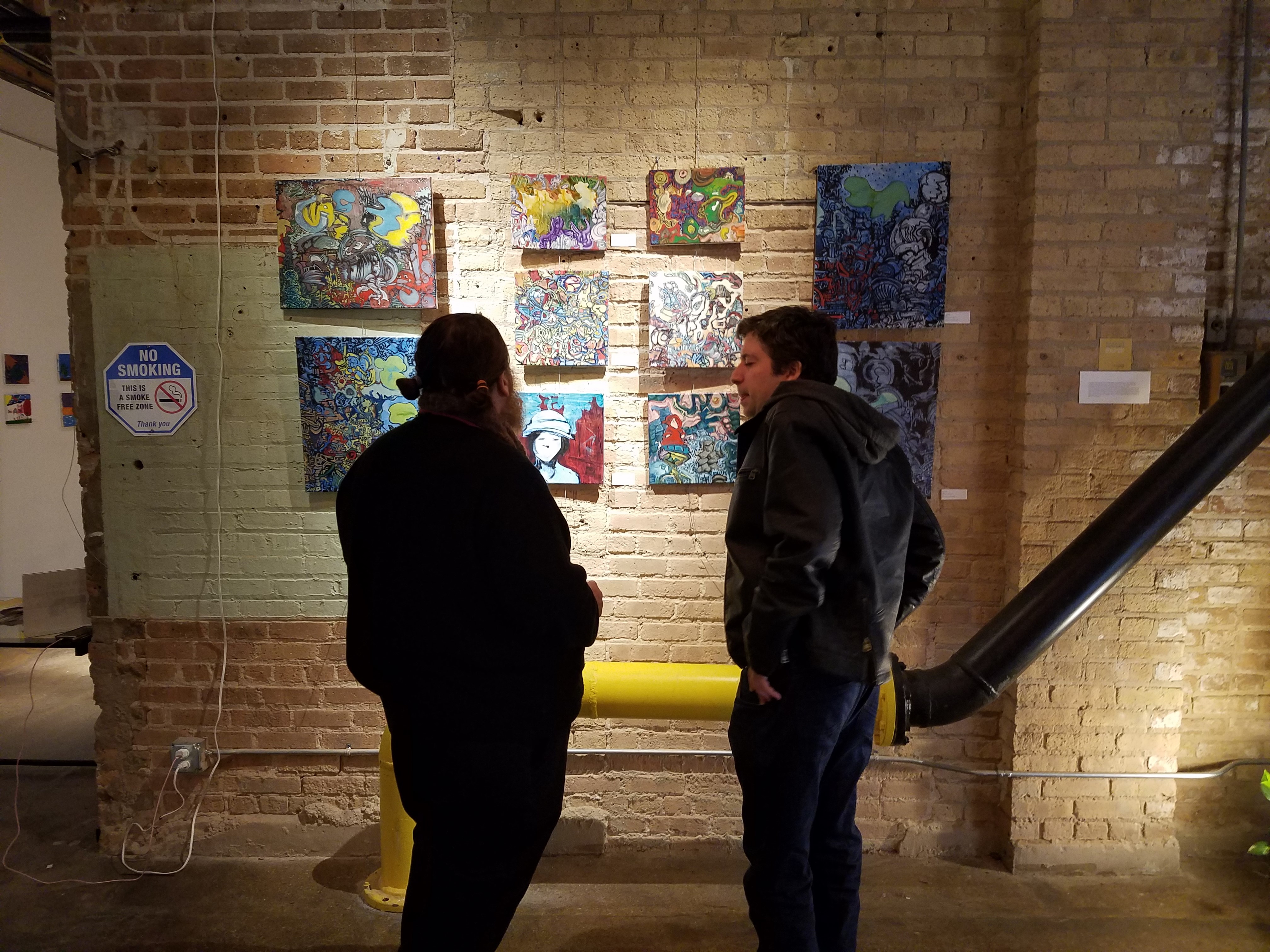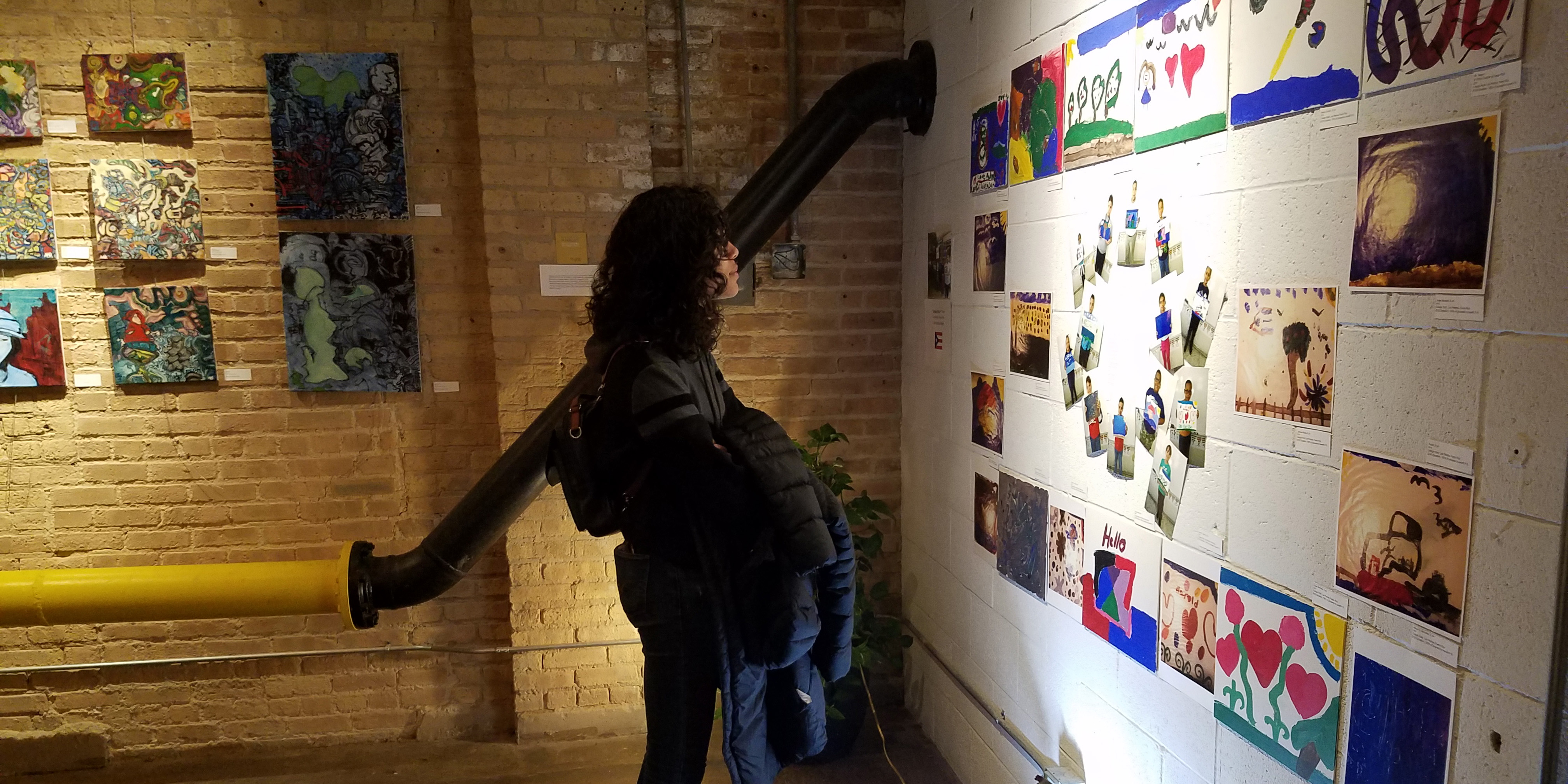Chicago’s arts and Puerto Rican communities are coming together at Workshop 4200 in Hermosa to celebrate the “Sowing Seeds, Harvesting Dreams” fundraiser art exhibit.
The exhibit, which runs from November 16 to December 28, is organized by arts nonprofit Arte al Rescate, which was created to fundraise for relief efforts in Puerto Rico, as it continues to face infrastructure and economic problems related to Hurricane Maria in 2017, such as a lack of educational centers, closed businesses and unreliable utilities. This year marks the third annual installment of the fundraiser-exhibit, and for the first time the exhibit features the work of youth artists from Chicago and Puerto Rico.
Funds from Arte al Rescate specifically go to efforts to rebuild infrastructure and provide educational supplies to schools and students. Erica Sanchez, co-founder and vice president of Arte al Rescate, said that though it has been more than two years since the hurricane struck, people on the island still lack access to open schools, reliable utilities, and mental health programs.
“A lot of schools had to close down due to infrastructure,” said Sanchez. “The rate of depression, anxiety, and post-traumatic stress has gone up so much in these past few years.”
She also noted that tourism still hasn’t picked back up to its pre-hurricane vitality, which has hurt the island’s economy. People lack jobs and coastal businesses especially have not recovered.

A view of the entrance from the middle of the exhibition (Christopher Silber, 14 East)
Supporting a Cause
Arte al Rescate works to address needs in Puerto Rico through supporting a variety of programs. The organization does a yearly back to school drive to raise funds for school supplies, such as backpacks, which are sent directly to Puerto Rican students. Sanchez said some funds also go towards mental health programs.
“We help send supplies to an at-risk young adult program in Puerto Rico that uses supplies for art therapy,” Sanchez said.
The organization has also donated to help complete mural projects in Puerto Rico and fix things such as damaged roofs.
“There was a man who needed about $700 to finish the roof of his house, and we were able to give him those funds. And then the community rallied around and completed that project,” Sanchez said.
This exhibit’s proceeds will go toward the organization’s back to school drive in 2020. Sanchez’s sister, Tanya, lives in Puerto Rico, and has been the organization’s main point of contact for allocating relief funds. The two were born in Chicago, but are of Puerto Rican descent. Tanya moved to Puerto Rico 22 years ago, and has lived there since.
“This is really centered around children and young people, which is very exciting,” said Erica Sanchez.
The art featured in “Sowing Seeds, Harvesting Dreams” consists of work from students aged 8 to 17 from schools in Chicago and Puerto Rico, pieces by professional artists from both regions and submissions from area residents. The student work focuses on the effects of the hurricane and the effort to rebuild, with symbols of support, Puerto Rican pride and the island’s landscape constituting much of the imagery. All the student work on display is for sale, with 100 percent of proceeds going to hurricane relief. Portions of sales from professional artists’ works also go toward relief funds. Most pieces are paintings ranging from $100 to $500.
The exhibition is set up in a long hallway-corridor. The works of various schools are grouped together on the walls with pieces from professional artists mingled in as one walks through. Toward the end of the gallery is a silent auction, an interactive artspace, and the studio of Arte al Rescate’s Janice Aponte. The corridor is warm and spacious, with places to sit and socialize.

Janice Aponte’s piece hangs at the entrance to the gallery (Christopher Silber, 14 East)
Janice Aponte: One Art Piece at a Time
Janice Aponte, president of Arte al Rescate and co-founder with Sanchez, had work featured in the gallery. She describes her art as feminine, colorful and warm. She described the nonprofit’s mission as “Rebuilding Puerto Rico, one art piece at a time.”
She said when Arte al Rescate first called for artist submissions shortly after the disaster, the response was global.
“We received pieces from London, from Spain, it was from all over the world,” she said. “People just really wanted to help.”
She said the current gallery is important because there is still need in Puerto Rico since the hurricanes in 2017. “The challenge right now is to continue creating awareness. A lot of people think it’s died down and everything’s okay but it’s not.”
Aponte specifically addressed the school systems’ need for support on the island. Because many schools were shut down, children often have to travel longer distances to reach educational resources.
“A lot of people had to leave Puerto Rico and come to the United States because of the situation with the schools.”
Aponte is Puerto Rican herself. She grew up in New York City and attended college in Puerto Rico.
She has been painting for about 18 years, and moved into her studio at Workshop 4200 two years ago. She said her work has evolved since moving to this space.
“[The new work] is more abstract, more loose,” she said. “It reminds me of Chagall and Van Gogh.”

Aponte’s new work (below) has a different artistic style than her older work (above) (Christopher Silber, 14 East)
Student artists in Chicago
Artwork from students at CICS Basil, a K-8 charter school in Back of the Yards, was displayed alongside work from their art teacher, Juan Carlos Baez. The students’ works display scenes common in the gallery: the Puerto Rican flag, images of homes on the island’s land and symbols of support and cooperation.

(Top) “Helping Hands” by Trenequa Hinton, Basil Charter School. (Below) “Puerto Rico, Becoming One” by Jorjanay Sambula, Basil Charter School (Christopher Silber, 14 East)
Baez, who led the students in their creative process for their art pieces, was born in Puerto Rico, and moved to Chicago as a teenager. His artwork has been displayed in shows and galleries in the Chicago area for more than 30 years. Much of his fine art is surrealist and focuses on themes of diaspora.

Baez’s work “Exodus Redux” (2019) hangs on the exhibition wall (Christopher Silber, 14 East)
His largest piece at the show, titled “Exodus Redux,” depicts a specific story about Hurricane Maria. Baez and his family had been living in Puerto Rico for three years, and returned to Chicago two days before Hurricane Maria hit the island.
Aponte said of his main pieces on display at the gallery, “It’s a series he has of all these astronauts. They’re Puerto Rican and they’ve landed on the ‘moon.’”
The pieces use the concept of astronauts landing in a different world to depict Puerto Ricans going to different lands. In other pieces, astronauts are displayed on the moon planting the Puerto Rican flag or playing the cuatro, the national instrument of Puerto Rico.
Student artists in Puerto Rico
Students from the Puerto Rican high school Academia Presbiteriana in the municipality of Carolina contributed ten pieces to the gallery. The students ranged from 8th through 12th graders, and their mathematics and art teacher Pricila Vidal also contributed a piece.
Accompanying each piece was a description written in Spanish and a photograph of each student holding their work.

Works from the students at Academia Presbiteriana (Christopher Silber, 14 East)
The students juxtaposed scenes of Puerto Rico before, during and after the hurricane and efforts to rebuild the island. Like the work from students at Basil, the flag played a central role in the imagery.
Some students focused on the unity and good that came out of catastrophe. A piece by Alondra K. Ramos is titled “Lo bueno de un desastre.” The Spanish description reads, “Quise expresar que las noticias hicieron reportajes sobre lo malo y el desastre que dejo Maria, nunca dearon saber la union y todo la bueno que salio de este catastrofe.” which translates to “I wanted to express that the news reported about the bad things and the disaster that Maria left, never knowing the union and all the good that came out of this catastrophe.”

Ramos’s piece, “Lo bueno de un desastre” (Christopher Silber, 14 East)
Colegio Rubi, Stolen Paintings and Andy Ball
Work from 4th-graders at Colegio Rubi in Las Piedras, Puerto Rico, was also featured at the gallery. While 19 original paintings were supposed to be displayed at the gallery, ten did not make it, and their photocopies were shown.
“Unfortunately the car with the paintings was vandalized, so there were ten pieces that did not make it to the exhibit, which are the ones that you see copied,” Aponte said.
The paintings, which included depictions of landscapes, trees and hearts were displayed alongside the photocopied missing paintings in a circle, with photos of the students in the middle of the circle.

Work from the students at Colegio Rubi (Christopher Silber, 14 East)
The story of the stolen paintings reached many Chicagoans when it ran on WGN, and during the organization’s outreach effort to find the loss paintings, many Chicagoans reached out to Arte al Rescate in support.
Aponte said, “People started hearing about it, and they were like ‘Oh my God, how can we help make up for the loss?’”
Andy Ball, local artist and English professor at Malcolm X College donated ten paintings to the exhibition to make up for the ten which were lost.
“He donated these ten pieces, so metaphorically it’s like rebuilding again what was lost,” Aponte said.
Ball said he was particularly interested in donating pieces for the cause of funding education. “Being an educator, I feel like kids need a school, so I’m happy to help out the cause.”

Ball (left) discusses his artwork with another gallery attendee (Christopher Silber, 14 East)
In describing his own work, Ball said he likes the concept of viewer participation, and that he purposely leaves his pieces a little unfinished and without definite meaning.
“I think we live in a world where everything is super polished and nothing is memorable, whereas people notice those tiny little accidents that happen that aren’t supposed to be there,” Ball said. “I know what I see, but if somebody else sees something else, that’s equally as valid, and I love that, because then it’s an actual connection between the artist, the art, and the viewer.”
Ball’s pieces were displayed in a corner of the gallery near the pieces from students at Colegio Rubi. Alisa Scott, co-curator of the exhibit, said this was done with the specific intent to show love.
“The brick wall with Andy Ball’s pieces transitions nicely into the white wall with the children’s art that was stolen. I chose that corner and that space specifically because I liked that it felt very enclosed and intimate, because in my opinion it mimics a hug.”
Scott said she set up the exhibit with the perspective of children in mind.
“You want to consider some aspect of storytelling. For this organization specifically, it’s very important for us to view this tragedy through the eyes of children so that people can better understand the importance of this cause.”

The exhibition corner, featuring both Ball’s and Colegio Rubi’s works (Christopher Silber, 14 East)
Alfredo Bauza and Puerto Rican Community in Chicago
Some artists whose work is on display have intimate connections with both the Chicago and Puerto Rican community. One artist, Alfredo Bauza, was displaced by Hurricane Maria and found refuge through Arte al Rescate.
“We sponsored him when the hurricane happened two years ago,” Aponte said. “A lot of the artists [in Puerto Rico] were displaced. They lost their studios. It was a disaster.”
Bauza is an award-winning artist who has taught workshops at 62 municipalities in Puerto Rico. He attended the opening of the “Sowing Seeds, Harvesting Dreams” exhibit, where he painted a large piece in only ten minutes.

Bauza paints a landscape in ten minutes (Christopher Silber, 14 East)
While Bauza is part of the Puerto Rican community that came to the United States as a result of hurricane Maria, other artists that represent the Chicago Puerto Rican community have roots earlier in the city’s history.
Patricia Perez, a contributing painter, said her father came to Chicago from Aguada, Puerto Rico, in the 1960s.
“My father was a part of that big migration of Puerto Ricans that came in the ‘60s. They settled in Lincoln Park, then Lakeview.”
Perez herself was born in Chicago and grew up in Lakeview. In the middle of the 20th century, Puerto Rican migration to Chicago peaked, as many came to work in manufacturing. In the early 1960s, Puerto Ricans were concentrated in the Lincoln Park, West Town, and Humboldt Park communities. Many were displaced into different communities through urban renewal policies the city targeted at neighborhoods like Lincoln Park.
Puerto Ricans have a long history of community activism in Chicago. The Young Lords were formed in Lincoln Park in the 1960s in an effort to organize against displacement. The Division Street Riots of 1966 in Humboldt Park marked the first Puerto Rican-led riot in the United States. The riot was meant to combat police mistreatment of the Puerto Rican community, and was sparked after a Puerto Rican man was shot by a policeman.
Perez said she has many family members in Puerto Rico, and they decided to stay and weather the hurricane.
“It’s hard to believe, but they’re still rebuilding,” she said. “Unfortunately some people left their homes, but my family decided to stay and tough it out. It’s home.”
Perez set up an installation at the exhibit in which attendees could color individual pieces of a 48-tile art piece, and once all the pieces were completed, they would be pieced back together as a final artwork.
“We need the community to help us put it together. That’s the idea, I think, behind Arte al Rescate. Community makes things happen,” Perez said.

A section of the interactive Art Installation. Photo courtesy of Arte al Rescate.
Today, Puerto Ricans are the second largest Latinx group in Chicago, behind Mexicans. While Division Street in Humboldt Park remains the community’s cultural center, neighborhoods north and west of Humboldt Park, including Belmont Cragin, Logan Square and Hermosa, hold a large Puerto Rican population.
The exhibit featured pieces donated from residents from surrounding communities and Hermosa, where Workshop 4200 resides.
Miriam Andrades, a young Chicago resident, contributed the piece “The Rise of Puerto Rico.” She said it was exciting to be in a gallery that focuses on her heritage.

“The Rise of Puerto Rico” by Miriam Andrades (Christopher Silber, 14 East)
“I’ve gone to galleries downtown, and this is different. It’s more home to us,” Andrades said. Her grandparents are from Puerto Rico. Much of her art focuses on her Puerto Rican family.
Learning and Growing
Some visitors to the exhibit came to learn about the Puerto Rican community in Chicago.
Alyssa Corrigan, the research and development assistant at the National Museum of Puerto Rican Arts and Culture in Humboldt Park, has lived in Chicago for three years, and said she has been putting in more time to learn about and support local Puerto Rican organizations.
“I’ve been trying to focus on supporting the artists that are here. This specific event I wanted to go to because it focused on bringing relief funds to the island, and the fact that there would be children’s artwork displayed.”
Along one of the walls in the gallery, colored-in papers from sixth graders at Rafael Irizarry Rivera in Peñuelas, Puerto Rico are displayed. Arte al Rescate often sends activity sheets to schools inside donated supplies such as bookbags.

Drawings from sixth graders at Rafael Irizarry Rivera in Peñuelas, Puerto Rico hng on the wall (Christopher Silber, 14 East)
Aponte said they weren’t expecting to get the coloring sheets back, but the class at Rafael Irizarry Rivera sent them anyway.
“I told Erica [Sanchez], we need to get those back all the time, so we can put them out and showcase them!”
Sanchez said Puerto Rico has begun to see regrowth, but support is needed to continue the process.
“My grandmother’s avocado trees came back, and she can have avocados again. So we are seeing things come back, but we still need so much support for our infrastructure and tourism to come back.”
Sanchez expressed hope that the exhibition could generate momentum through December.
“These kids have been really great, and I’m excited,” Sanchez said. “We’re going to keep it up all month, so people can drop in and check it out through December 28.”

The view from the gallery entrance as visitors walk through (Christopher Silber, 14 East)
Header image by Christopher Silber, 14 East
Note: Upon publishing, the exhibit was to run from November 16 through December 21, but the exhibit has since been extended to December 28. The article has been amended to reflect the new date.




NO COMMENT